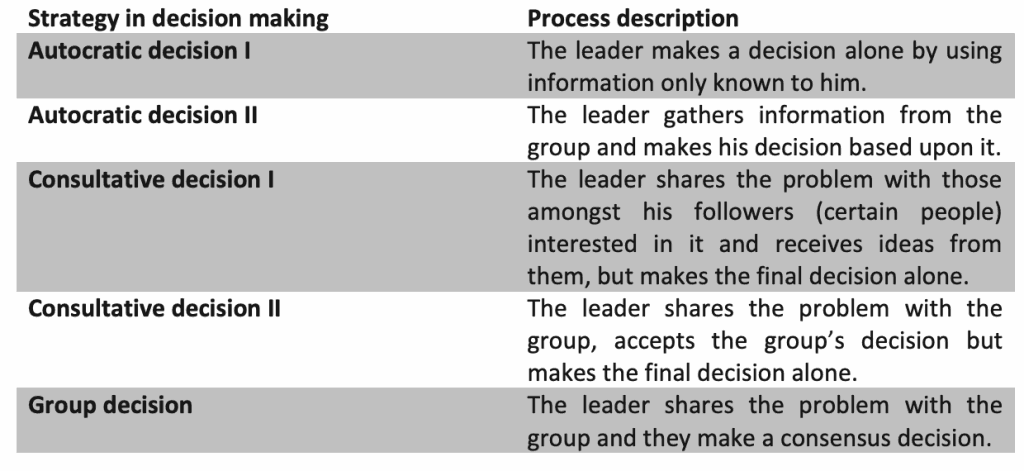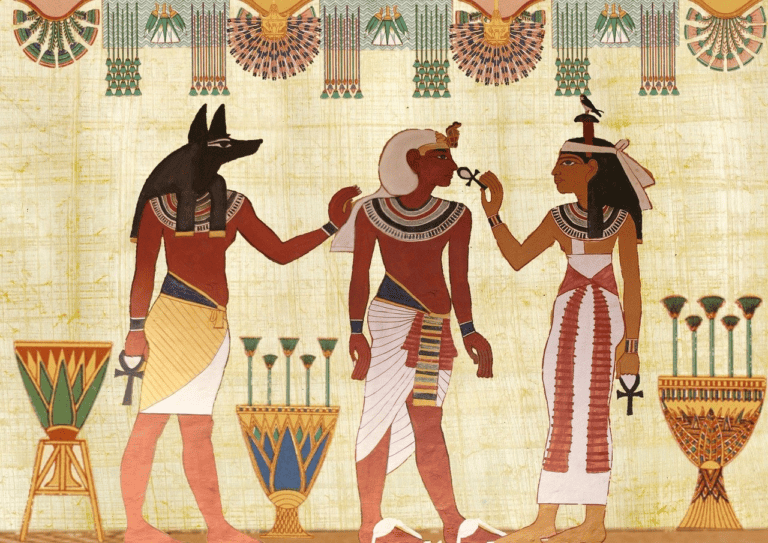Decision Making and Problem Solving
Decision Making and Problem Solving
Leadership & Decisions
After we have finished discussing the differences between leadership and management, we will try to explore one significant similarity between them – the need for decision making. The word ‘leadership’ comes from English and means ‘leading, directing’. The term ‘management’ also comes from English and has the meaning of ‘governing, guiding, coping with (a certain task)’. Although the two words show different approaches, attitude and manner, a leader and a manager have one task in common – achieving a specific goal. During this process they must plan, analyze, control, correct, communicate as well as constantly make various decisions. More often than not, the ability to make decisions considerably distinguishes a leader from his followers. The difficulty in making a decision is not related to the decision itself, but more likely to the responsibility being held for the consequences and results of that decision.
“The theory of decisions states that a leader may make work-related decisions by using different strategies. They are arranged from a unilateral decision (autocratic decision making) to a decision based on the group’s consensus (decision making completely by the group). In the latter, the leader takes up the role of a simple participant within the group” (Riggio R, 2003, p. 354).
The five strategies of decision making are shown in Table 2.
Table 2. Strategy model of decision making

No matter which of the strategies a leader will employ, in the end, he takes personal responsibility for the results and consequences of the decision taken. The strategy of group decision must not be perceived or employed with the goal to release a leader from the responsibility of the decision taken or to transfer it to the group.

THE PROCESS OF DECISION MAKING
Decision making is not a single act but a continuous process for the leader. Usually, solution to particular problem requires a number of decisions. Some of them are hard and require a lot of resources. Others are with a lower level of complexity and leaders often make decisions 17 “on the go”. It is important to note that decisions are made as an attempt to solve a problem. If there isn’t a specific event causing problems, there is no need for decision making. In order to study the stages of decision making, it is vital for them to be included in the bigger picture of problem solving.
The leader accomplishes specific steps in this process (Kahneman, Tversky, 2000):
Analyzing the problem – the most important stage in problem solving. Adequate analysis is the basis upon which all decisions are made. In order for an analysis to be successful, we need to gather information. The important thing here is that a lot of information does not always equal meaningful information.
Setting limits and criteria for decision making – every decision is made conforming to certain criteria and under the influence of limitations. The most universally valid limitation is the validity of the decision. No matter how rational or good a decision is, if it cannot be achieved with the current resources, then it is rendered inadequate. Criteria are related closely to limitations and provide an answer to the question: How do we know what a good decision is? The most widely used criteria in practice are the time needed to accomplish the decision and how cost-effective it is.
Generating alternatives – when we have just one decision at our disposal, then it always seems to be the most appropriate. In order to follow up with choosing the most appropriate decision we need to have at our disposal a number of possible decisions. Not only will they ensure the success of our choice, they could become vitally important if subsequent changes need to be made. Most often these changes are the result of the dynamics of the limitations.
Evaluating the alternatives – the whole range of generated decisions is submitted for analysis. This analysis is done by evaluating every decision by examining its compatibility with the criteria and limitations, on the one hand. On the other hand, a prognosis of the expected results from each and every decision is prepared.
Choosing a decision – after we have a sufficient number of alternatives and each and every one of them had its compatibility with the criteria and limitations properly evaluated, the only thing left is to choose the decision to be made. Usually, it is the one that is expected to bring the most favorable outcome (Schacter, Gilbert, Wegner, 2011).
WAYS FOR DECISION MAKING
In essence, the leader is a product of personal qualities and the circumstances of the situation. Because there is no universal mold for a leader, it is assumed that every person may show leadership. Thus, different leaders make decisions in different ways. It is well known for a fact that women have highly developed intuition, sensitivity and sentimentality. It may be expected from them that they will make a decision under the influence of these qualities. Men are in the habit of relying on facts, proof and, in general, are predisposed to being rational. This example does not aim to sexually discriminate but to illustrate how personal experience may influence the way decisions are made.
When making a decision, the director finds himself under the influence of such psychological factors as: social environment, acquired experience and personal values” (Angelov, 1998, p. 97-98). Angelov distinguishes three approaches to decision making:
- Intuitive decisions– these decisions are based on the subjective inner belief that the choice is the right one. In order to make such a decision, no information needs to be gathered. Intuitive decisions are related to social phenomena such as attitudes, projection and attribution. A leader does not need to understand a problem because he fully relies on his inner confidence. This type of decisions can also be regarded as emotional.
- Decisions, based on logic – as much time as needed is devoted to acquaint oneself with a problem. A leader uses his knowledge and skills in order to arrive at the most suitable choice for a decision. The more experienced a leader is, the easier it is for him to make a logical decision in view of often encountered issues. This approach is suitable when making work-related decisions which do not require creativity or generating a sufficient number of alternatives.
- Rational decisions – decisions are made using the above mentioned formula. The leader sets aside his personal feelings (intuition) and past experience (logic) when making a decision by using the principle of “Here and now”. He follows strictly the steps for decision making, without introducing into the process any personal element whatsoever. In order to choose the best decision he only needs actual facts.
From this classification of decision making types it is evident the strong influence that a leader’s individuality has on the way he makes a choice. There is another aspect in the theory of leadership, which is strongly influenced by a leader’s personal qualities. It is his style.
LEADERSHIP STYLE AND PROBLEM SOLVING
Personal qualities are most visible in the style which a leader employs. The theory of leadership styles is a behaviorist one. The primary goal of this theory is to create a relatively sustainable model of a leader’s behavior through observation, which allows the prediction of his actions. In other words, after observing the basic styles of leadership, we will be able to easily predict the way any leader would approach problem solving.
“Some leaders hold discussions, others demand obedience, some command, others give instructions, some coerce, yet others negotiate, some apply pressure, others seek out experts etc. Different leaders use different tactics of persistence, manipulation, supplication, praise of others, indifference, reward, threat, punishment. Moreover, if it suits the situation, the leader and the needs of the group, anyone of these tactics may meet success” (Todorova, 1995, p.214).
“Leadership style or the style of a leadershowsthe way in which he uses communication, puts in motion ideas and motivates people. This style is the result of a leader’s philosophy, personality and experience” (Tittemore, 2003, p. 49).
The behaviorist paradigm distinguishes three basic styles of leadership – autocratic, authoritative and democratic.
- Autocratic leadership – it is generally related to use of power or forcing one’s personal opinion. This type of leaders has absolute power over their followers. They are not willing to compromise or develop alternative solutions. They prefer to make decision by themselves and only afterwards do they inform their followers by forcing them to follow the regulations constantly. Autocratic leaders are predisposed to render 19 excessive formal limitations when making decisions. They usually do not have enough information at hand because they seek to do everything by themselves. They try to approach problems rationally, but it often turns out that their approach was intuitive or emotional. They perceive success as personal and failure as an act of the group.
- Authoritative style – a leader cooperates with his employees but keeps his status as “different” from the rest of the group’s members. These relations between a leader and his followers can most accurately be described by the phrase “First among equals”. The leader is capable of listening and discussing various decisions. He strives to acquire maximum relative to the issue at hand information. Discussions are constructive, based on knowledge, experience and professionalism. He is open to suggestions which are scrutinized. He prefers to solve the current issues alone but if more complex one arises, he is willing to discuss them with the group. This type of a leader may set adequate limitations when generating alternatives. No matter what the result of the given decision is, he shares it with the group.
- Democratic style – it is traditionally related to the refusal of taking responsibility for the consequences of the decisions made. This type of leaders are willing to share the problem with the group after which they become ordinary members and discuss it from this position. They readily refuse the formalities and endeavor to have informal relations. Their primary goal is to be popular among their followers. Never do they make decisions alone, they only announce those made by the group. They do not take into consideration the limitations and do not impose criteria for generating alternatives. Like autocratic leaders, they are willing to perceive success as personal, and failure – as that of the group.
In reality it is impossible to have a “pure” style of leadership. Most leaders have traits from all three styles but one always dominates over the rest. The most suitable and sensible thing is for a leader to be capable of transforming his style depending on the specific situation and the issue at hand. Sometimes the inflexibility of the autocratic leader is required; sometimes the expert knowledge of the authoritative one, and when solving a concrete problem, the removal of all limitations by using the democratic style may be most beneficial. No matter the style of leadership, the most important thing is to make the right decision.
TO SUMMARIZE
- Making decisions is an essential function of leadership, which directly corresponds to leadership power.
- There are five strategies for making decisions. They are determined by how closely followers are involved in this process. No matter which one of them is used, the leader assumes personal responsibility for the consequences of the decisions made.
- The procedural approach to problem-solving defines five stages – analyzing the problem, setting limitations and criteria, generating alternatives, evaluating alternatives and choice of decision.
- There are three main approaches to decision making, which are directly related to the leader’s personality – intuitive, logical and rational.
- The style of leadership is directly related to the way decisions are made. It may serve as a pointer to help predict decisions. The styles of leadership are autocratic, authoritative and democratic.
REFERENCES
Darr, S. (2004) Introduction to Management and Leadership Concept, Principles and Practices.
French, R., Rayner, C., Rees, G., Rumbles, S. (2011) Organizational Behavior, United Kingdom.
Kahneman, D, Tversky, A. (2000) Choice, Values, Frames, Cambridge University Press.
Riggio, R. (2003) Industrial / Organizational Psychology, New Jersey.
Schacter, Gilbert, Wegner (2012) Psychology (2nd Edition), Worth Publishers.
Tittemore, J. A. (2003) Leadership at all Levels, Canada.







